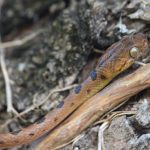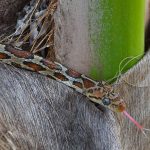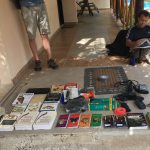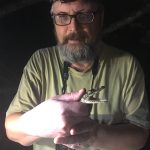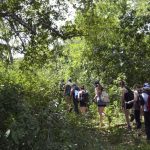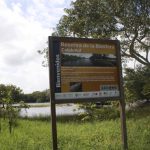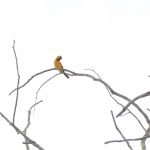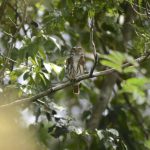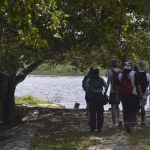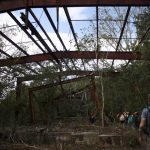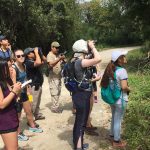For the early risers in the group the day started around 6:30 -7:00a.m. to catch the dawn birds. Before even leaving the compound we saw the second smallest owl in Mexico, the Pygmy Owl (Glaucidium brasilianum), along with a golden-fronted woodpecker, a boat-tailed grackle, and various dove and pigeon species. After leaving the compound we learned about the Tilandsia epiphytes lining the telephone wires and how these plant species thrive in extreme environments with no soil for their roots. Over the rest of the bird-watching trip we observed various flora and fauna such as a cycad (an exotic) and social flycatchers. Before we made the trek back for breakfast we found a dead female rattle snake that was hit by a car.
After everyone was awake and fed we made our way down to the Calakmul Biosphere Reserve lagoon here in Zoh-Laguna. On the way there through the village we observed the local domestic species and was astounded by the number of dogs roaming the streets. Once we arrived at the lagoon we were welcomed with a beautiful view and cool breeze. At the south end of the lagoon sat an anhinga, a large fish-eating bird, perched high on a tree potentially sunning itself. As we travelled deeper into the reserve the diversity continued to expand and create ties to home when we found a migratory northern water thrush )a wood warbler with a largely terrestrial habit) that had flown south to enjoy the warm Mexican climate (with temperatures of high 20’s despite the ‘cold front’ called a ‘norte’ moving through). There were plenty of birds to be seen including a magnolia warbler (a neotropical migrant), indigo buntings, three species of hummingbird and the another pygmy-owl. It was also here where a local journalist (from Campeche) told us about the abandoned saw mill once run by Polish owners. Many valuable tropical trees such as mahogany that are used for high end (and expensive!) furniture are harvested in Mexico, a lot of these trees were actually milled and prepared right here in Zoh-Laguna! Before heading back for lunch Dr. Lougheed, Jesus and Javier continue to educate us on the diversity and adaptations of various species such as a turkey vulture (Catharses aura) that circled overhead which have flow through nostrils to smell carrion hidden below.
Following a filling lunch, we started the first of the seminars, being taught by our peers; we learned about various topics relating to biodiversity such as the geological history of the Yucatan and why the diversity is highest in Central America (i.e. why is there a latitudinal gradient). To end the day, we went for a night walk back down at the lagoon. Only lit by the light of headlamps to scan the surrounding, we found a variety of life lurking in the darkness. Leaving empty trails in the day, leafcutter ants created paths cleared of vegetation carrying leaves back underground to feed the fungal ‘gardens’ that they rely on for food. Before the nights end we spotted two snakes and a baby alligator. We found all three of these species at once in the same area which meant Renee got to hold one of the snakes while Dr. Lougheed went for the baby crocodile. We put the two snakes into bags to bring back with us so that we could get photos in the daylight and identify them. The two snakes we found were a tropical ratsnake, Pseudelaphe flavirufa (relative of gray rat snakes that can be found at the Queen’s University Biological Station) and small spotted cat-eyed snake, Leptodeira polysticta. The crocodile was possibly Crocodiles moreletii, although it is hard to tell in the juveniles. With these exciting finds to end the night, the alligator was returned to the water and we made our way home to prepare for our next adventure-filled day!
Español
Para los madrugadores del grupo, el día inició entre 6:30 a 7:00a.m., para observer aves. Aún sin salir del histal, observamos varias especies, incluyendo un tecolotìto pigmeo (Glaucidium brasilianum), juxnto con un pájaro carpintero, un zanate y varias epecies de palomas. Ya que nos fuimos a explorar en el pueblo, aprendimos sobre cómo plantas epífitas (Tilansia) observadas sobre los cables de luz, de cómo pueden sobrevivir en ambientes extremos sin suelo donde anclar sus raíces. A lo largo de la excursion observamos más aves y otras especies de la flora y la fauna, incluyendo una palma cycada y un mosquerito gregario social. Antes de de regresar al hostal, encontramos una serpiente de cascabel atropellada en la calle.
Ya que todos despertaron y desayunamos, fuimos a caminar hacia una laguna dentro del poblado de Zoh-Laguna. Durante la camintata, observamos especies domésticas, pero estabamos sorprendidos de la cantidad de perros en la calle. Cuando llegamos a la Laguna nos gustó el bonito paisaje y la briza fresca. Hacia la parte sur de la laguna observamos una Anhinga, un ave grande pescadora perchando sobre la punta de un árbol en busca de alimento. Explorando un poco más, encontramos una especie de ave migratoria que nos recordó a casa, pués migra desde el norte del continente para pasar el invierno en las tierras mexicanas más cálidas donde la temperature del día estaba en los 20º, a pesar de un frente frio presente en el momento. Habia otras aves presents, incluyendo el Chipe de magnolia (Setophaga magnolia), Colorín azul,colibries y otro tecolotito tropical. Nos encontramos a un reporter local que nos exlicó sobre el acerradero abandonado. Mucha madera tropical valiosa como la caoba usada para muebles caros se cosechaba en esta parte de México. Mucha de la madera era procesada en Zoh-Laguna. Antes de regresar al Hostal, el Dr. Lougheed, Jesús y Javier, contnuaron instruyendonos sobre la biodiversidad y sus adaptaciones, ejemplos con un zopilote negro que tiene surcos especiales sobre su pico para poder olfatear major la carroña no visible.
Despúes de comer, iniciamos la presentación de seminarios, aprendimos de nuestros compañeros sobre varios aspectos relacionados a la biodiversidad, incluyendo la historia geológica de Yucatán y de porqué la biversidad biológica es más alta eb Centroamérica. Para terminar el día fuimos a una caminata nocturna de regreso a la Laguna. Usando nuestras lamparas escaneando el paisaje y la laguna observamos un buen de actividad animal en la obscuridad. Habiendo senderos vaciós durane el día, durante la noche sin embargo observamos una densa fila de hormigas corta-hojas llevando material vegetal a sus nidos para su cultivo de hongos del cual se alimentan. Antes de que terminara nuestra caminata nocturna, encontramos dos serpientes y un cocodrilo pequeño en el mismo sitio a la vez; Rene tuvo en sus manos una de las serpientes mientras el Dr. Lougheed atrapaba el cocodrilo. Pusimos las dos serpiestes en bolsas de tela para llevarlas e identificarlas y sacar fotos como registro. Una de las sserpientes fue identificada como Pseudelaphe flavirufa y otra como Leptodeira polysticta, la especie del cocodrilo fue Cocodrilus moreletii Con estos grandiosos descubrimientos terminamos nuestra exploración nocturna, regresamos el cocodrilo a la laguna y nis fuimos al hostal y prepararnos para otro día de aventuras.
